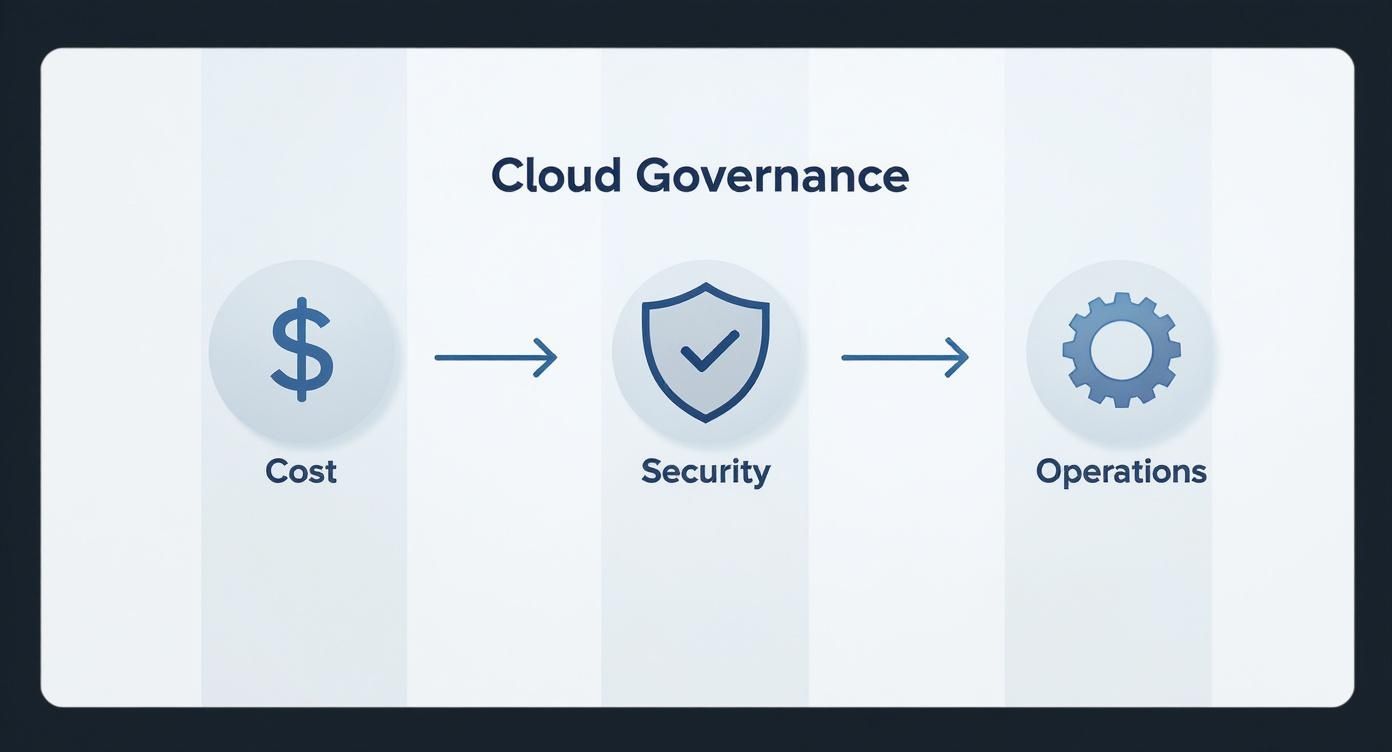Mastering Governance in the Cloud
Ever had that sinking feeling when you open the monthly cloud bill? Or maybe you’ve felt the pressure of constant security alerts pinging from your cloud environment. It’s a common story. This is precisely where cloud governance comes in—not as a set of rigid, stifling rules, but as a smart, strategic framework for your entire digital operation.
Think of it as the playbook that ensures your cloud environment is secure, cost-effective, and perfectly aligned with what your business is trying to achieve.
Unpacking What Cloud Governance Truly Means

Imagine trying to build and manage a city without any zoning laws, building codes, or traffic management. It would be absolute chaos. Buildings would pop up anywhere, traffic would be a nightmare, and public services would be a mess. Without a solid governance plan, your cloud environment can become the digital equivalent of that chaotic city—sprawling, expensive, and dangerously insecure.
The entire point of cloud governance is to bring order and predictability to that potential chaos. It’s about establishing clear, sensible “rules of the road” for how everyone in your organization uses cloud resources. This framework doesn’t slow people down; it actually empowers your teams to innovate and build incredible things safely, without racking up surprise costs or introducing critical risks.
Moving Beyond Jargon to Practical Control
At its core, cloud governance isn’t just some IT checklist; it’s a fundamental business strategy. It tackles the very real headaches that pop up when cloud adoption isn’t managed properly. These challenges typically boil down to four key areas that a good governance strategy is designed to solve.
Effective governance helps prevent:
- Budget Overruns: It shines a light on exactly where your money is going and enforces policies to stamp out waste. No more shocking end-of-month bills.
- Data Breaches: By defining clear security standards and access rules, governance drastically reduces vulnerabilities and keeps your sensitive data locked down.
- Compliance Failures: It ensures your cloud setup meets all the necessary industry regulations (like HIPAA or GDPR) and your own internal corporate standards.
- Operational Gridlock: Governance drives consistency and automation, which means less time spent fixing random configuration issues and more time spent on productive work.
The goal isn’t to restrict innovation. It’s to enable it by creating a safe, predictable, and cost-effective environment. When developers have clear guardrails, they can move faster and with more confidence.
A solid governance model is the foundation you need to scale sophisticated cloud services and adopt powerful new technologies like AI. It guarantees that the infrastructure powering these tools is stable, secure, and financially sustainable—a must-have for any organization serious about getting the most from its cloud investment.
The Foundational Pillars of Governance
A truly effective cloud governance strategy is built on a few core pillars. These aren’t separate, siloed functions; they all work together to create a single, cohesive plan. Each pillar addresses a specific area of concern, from cost to security, bringing much-needed clarity and control to your cloud operations.
Understanding these pillars is the first step. For example, airtight security policies are useless if they’re so complicated that they bring operations to a halt. Likewise, cost controls that choke off necessary innovation do more harm than good. It’s all about finding that perfect balance.
Navigating this complexity is where expert guidance, like that from strategic cloud consulting, can be a game-changer. An expert can help ensure your governance strategy is not just comprehensive on paper but is also perfectly aligned with your unique business goals, allowing you to build and scale without compromise. We’ll dive deeper into each of these pillars next.
The Pillars of a Rock-Solid Governance Framework
A strong cloud governance framework isn’t just a set of vague ideas. It’s built on five concrete pillars that bring structure, security, and financial predictability to your cloud environment. Each pillar tackles a specific challenge, but they all work together to create a single, cohesive strategy.
Think of it like building a house. Each pillar is a foundational support column. If one is weak or missing, the entire structure is at risk. By focusing on these five areas, you can transform a chaotic, reactive cloud setup into one that’s proactive, controlled, and perfectly aligned with your business goals.
Taming Your Cloud Spend with Cost Management
For many businesses, the first and most painful sign of poor governance is a shocking cloud bill. Without a solid cost management strategy, expenses can easily spiral out of control, fueled by forgotten resources, oversized virtual machines, and unmonitored data transfers. Good governance flips this script, moving you from reactive shock to proactive control.
This pillar is all about creating visibility and accountability. It starts with putting tools and processes in place to track spending as it happens, not a month later.
Key practices include:
- Budget Alerts: Set up automated notifications that fire off when spending gets close to your predefined limits. This early warning system helps you avoid those nasty end-of-the-month surprises.
- Resource Tagging: This is non-negotiable. Implement a consistent tagging policy for every single cloud asset. When you tag by project, department, or owner, you can easily see where the money is going and who is spending it.
- Rightsizing and Optimization: Don’t just “set it and forget it.” You need to constantly analyze how your resources are being used to spot and eliminate waste. This means downsizing oversized instances, deleting storage you no longer need, and using cost-saving models like reserved instances.
Building a Digital Fortress with Security and Compliance
Security isn’t a feature you bolt on at the end; it’s the foundation of cloud governance. This pillar is about building a digital fortress that protects your data, applications, and infrastructure from threats while making sure you stick to regulatory standards.
This means establishing security policies that are non-negotiable across your entire cloud environment. Critical components include strong data encryption—both for data sitting in storage and data moving across the network—and tight network security rules that only allow necessary traffic. For many, this also means meeting specific industry mandates. In fact, the global cloud compliance market was valued at USD 36.16 billion in 2024 and is expected to climb to USD 90.67 billion by 2030, showing just how critical this has become. You can read more about these cloud compliance market trends on Grandview Research.
A strong security posture is built on layers. It combines preventative controls, detective measures to identify threats, and corrective actions to respond to incidents swiftly and effectively.
Preventing Digital Clutter with Resource Management
As a company scales, its cloud environment can quickly become a messy, disorganized digital junkyard. This “digital clutter” makes everything harder—management is a nightmare, security risks multiply, and tracking costs becomes nearly impossible. The resource management pillar is all about bringing order to that chaos through standardization.
The core idea here is to create a logical and consistent structure for all your cloud assets. This is achieved through:
- Consistent Naming Conventions: A standardized naming scheme for resources (e.g.,
proj-env-app-resource-id) makes them instantly recognizable and much easier to manage. - Resource Grouping: Organize resources into logical groups based on the application they belong to, their environment (like development or production), or the business unit that owns them. This makes applying policies and access controls a breeze.
- Lifecycle Management: Automate how resources are created, updated, and eventually decommissioned. This simple step prevents the buildup of unused “zombie” assets that silently drain your budget and create security holes.
Controlling Access with Identity and Access Management
The Identity and Access Management (IAM) pillar answers one of the most critical questions in security: Who can access what? A sloppy IAM strategy is one of the most common ways breaches happen. Effective governance here is built on the principle of least privilege—a simple but powerful idea that users and systems should only have the bare minimum access they need to do their jobs, and nothing more.
This involves putting tight controls in place to manage identities and enforce access policies.
Key components include:
- Role-Based Access Control (RBAC): Instead of giving permissions to individual people, you assign them to predefined roles (like “Developer” or “DatabaseAdmin”). This makes management simpler and far more consistent.
- Multi-Factor Authentication (MFA): Requiring a second form of verification is a must. It adds a crucial layer of security that makes it significantly harder for a bad actor to get in, even if they have a password.
- Regular Access Reviews: Don’t just set permissions and walk away. Periodically audit who has access to what to find and remove permissions that are no longer needed. This closes potential security gaps before they can be exploited.
Ensuring Stability with Operations Management
Finally, the Operations Management pillar is all about creating a well-oiled machine. It focuses on making sure your cloud environment runs smoothly, reliably, and efficiently by standardizing how you handle maintenance, monitoring, and recovery. A solid operational foundation frees up your teams to focus on innovation instead of constantly putting out fires.
This pillar brings automation and predictability to day-to-day tasks. It covers everything from automated patch management to keep systems secure, to having a comprehensive disaster recovery plan that minimizes downtime if something goes wrong. Of course, effective cloud monitoring and observability are also essential here, giving you the insights needed to spot and fix issues before they ever impact your users.
Let’s break down how these five pillars support a robust cloud governance strategy.
Core Pillars of Cloud Governance
| Pillar | Primary Objective | Key Tools & Processes |
|---|---|---|
| Cost Management | To achieve financial visibility and control over cloud spending. | Budgeting and alerts, resource tagging, rightsizing, cost allocation reports. |
| Security & Compliance | To protect data and assets while adhering to regulatory requirements. | Identity and Access Management (IAM), data encryption, network security groups, compliance audits. |
| Resource Management | To organize and manage cloud resources efficiently and consistently. | Naming conventions, resource grouping (e.g., resource groups, folders), automated lifecycle policies. |
| Identity & Access Management | To enforce the principle of least privilege and secure user access. | Role-Based Access Control (RBAC), Multi-Factor Authentication (MFA), regular access reviews. |
| Operations Management | To ensure operational stability, reliability, and business continuity. | Automated patching, performance monitoring, backup and disaster recovery plans, incident response. |
By addressing each of these pillars, you create a holistic governance framework that not only reduces risk but also empowers your teams to build and innovate with confidence.
Your Step-by-Step Implementation Roadmap
Thinking about cloud governance is one thing, but actually putting it into practice can feel like staring up at a mountain. The trick is not to try and climb it all at once. A structured, step-by-step plan is your best friend here.
First things first: someone needs to own this. For most companies, this means pulling together a dedicated Cloud Center of Excellence (CCoE) or a specialized governance team. This group becomes the champion for the whole initiative, making sure the strategy not only gets off the ground but also stays aligned with what the business actually needs. Think of them as the architects and guardians of your cloud environment.
Phase 1: Assess Your Current Environment
You can’t map out a new route without knowing where you are right now. The first phase is all about discovery—getting a crystal-clear picture of your current cloud landscape to spot the biggest risks and the best opportunities. After all, you can’t govern what you can’t see.
This means rolling up your sleeves and doing a full inventory. Look at all your cloud resources, who has access to what, how things are configured for security, and—critically—where the money is going. The goal is to answer some tough questions:
- Where is our money actually going? Pinpoint the services and projects that are eating up the budget.
- Who has access to what? Hunt down any overly generous permissions or accounts that haven’t been touched in months.
- Are we exposed? Find potential security holes or spots where you might be out of compliance.
- What’s our biggest headache? Figure out if runaway costs, security worries, or just plain operational chaos is the most urgent fire to put out.
Getting solid answers here gives you the hard data you need to prioritize your next moves and focus on what will make the biggest difference, fast.
Phase 2: Define Clear and Actionable Policies
Once you have a clear picture of your environment, it’s time to set the rules of the road. These policies are the heart of your governance in the cloud framework, turning big-picture business goals into specific, enforceable rules. The key here is to avoid writing a 100-page document that will just gather dust.
Instead, create simple, direct policies that tackle the risks you’ve already identified. For example:
- Cost Policy: “All new production resources must be tagged with a ‘Project’ and ‘Owner’ label.”
- Security Policy: “Multi-Factor Authentication (MFA) must be enabled for all users with access to production environments.”
- Operations Policy: “All production virtual machines must have automated backups enabled with a 30-day retention period.”
Rules like these are clear, easy to understand, and much simpler to automate and enforce. As you write them, make sure to bring in people from finance, security, and development. This ensures the policies are practical and won’t bring productivity to a screeching halt.
This flow chart shows how the main pillars—cost, security, and operations—all fit together into one cohesive strategy.

This visual makes it clear that good governance isn’t a one-and-done task. It’s a continuous cycle of managing costs, protecting your assets, and keeping operations running smoothly.
Phase 3: Start Small With a Pilot Project
Trying to roll out a brand-new governance plan across the entire company from day one is a recipe for disaster. You’ll hit resistance from every corner. A much smarter move is to start with a pilot project. Pick a single application or a small, self-contained team to test drive your new policies in a controlled setting.
This approach gives you a few big wins:
- Test and Refine: You can find and fix any unexpected problems with your policies or automation tools on a small, manageable scale.
- Demonstrate Value: A successful pilot creates a powerful success story you can use to get buy-in from other teams and build momentum.
- Gather Feedback: The pilot team will give you priceless, real-world feedback to make the framework better before it goes out to everyone else.
This iterative process lets you fine-tune your approach, making sure that when you do go big, your framework is solid, practical, and maybe even popular.
Phase 4: Automate Enforcement and Communicate Widely
The final phase is all about scaling up that success. Trying to enforce governance policies by hand just doesn’t work long-term; automation is the only way to make it stick. Use the native tools your cloud provider offers—like AWS Control Tower, Azure Policy, or Google Cloud’s Organization Policy Service—to automatically enforce your rules. You could, for example, set up an automation that simply blocks anyone from creating new resources that don’t have the required tags.
At the same time, you need to be communicating constantly. Don’t just send out an email with the new rules; explain the “why” behind them to the whole organization. Run training sessions, create easy-to-read documentation, and be sure to highlight the benefits, like better security and more predictable costs. For companies that need a hand, digging into the details of a cloud migration services strategy can offer great insights for setting up governance right from the start.
By following this roadmap, you can build a governance framework that actually helps your teams, protects your environment, and keeps your cloud spending on a tight leash.
Cloud Governance in the Real World
Theory is great, but seeing governance in the cloud in action is where it really clicks. Let’s look at a few stories of businesses that wrangled their cloud environments with smart policies and deliberate control, turning potential chaos into a real-world advantage. These examples, much like the challenges we’ve solved in our own client cases, show how governance solves painful, everyday problems.
Think about a healthcare provider moving highly sensitive patient data to the cloud. The biggest hurdle isn’t just the migration itself; it’s maintaining bulletproof HIPAA compliance every single step of the way. Without a solid governance plan, this move is a minefield of potential data breaches and failed audits.
By putting a strong governance framework in place, the provider gets a firm grip on the situation. This means locking down access with strict Identity and Access Management (IAM) policies, ensuring only the right people can see patient records. Automated compliance checks also constantly scan the environment, flagging any configuration that drifts from HIPAA standards so it can be fixed immediately. The result? Compliance becomes a routine, not a crisis, and stressful audits turn into simple check-ins.
Securing Transactions in Fintech
Now, picture a fast-growing fintech company. Their entire business is built on trust, so complying with the Payment Card Industry Data Security Standard (PCI DSS) is absolutely non-negotiable. Even a minor security slip-up could be devastating.
Their governance strategy revolves around creating a walled-off, highly monitored cloud environment.
- Network Segmentation: They use virtual private clouds (VPCs) and tight firewall rules to completely isolate the systems handling cardholder data from everything else.
- Continuous Monitoring: Security tools are always running, watching for any suspicious activity 24/7 and sending real-time alerts about potential threats.
- Immutable Infrastructure: They use an Infrastructure as Code (IaC) approach. This means any change to the environment requires deploying a brand-new version from a controlled template, which dramatically cuts down the risk of human error during configuration.
This proactive approach to security is more than just checking a compliance box—it becomes a cornerstone of their brand, giving customers the confidence that their financial data is in safe hands.
Taming Costs in Retail Ecommerce
A retail business wrestles with a completely different beast: wildly unpredictable cloud costs, especially during huge holiday sales. Their Custom Ecommerce Solutions platform has to scale up in an instant to handle massive traffic spikes, but it needs to scale back down just as fast to keep the budget from exploding.
Here, the governance strategy is all about cost management and efficiency. They enforce a strict resource tagging policy, which lets them trace every single dollar of cloud spend back to a specific department, feature, or marketing campaign. They also use automated scripts to shut down development and testing environments after hours, cutting out a huge source of wasted spending.
The real business outcome is predictable finances. The retailer can now go into massive sales events like Black Friday knowing that the cloud bill waiting for them on the other side won’t eat up all their profits.
Governance in the Public Sector
This need for control isn’t just a private sector issue. Government cloud initiatives are changing how public agencies work all over the world. The global government cloud market was valued at USD 43.81 billion in 2024 and is expected to rocket to USD 190.66 billion by 2033. This boom is fueled by the need for better security, flexibility, and compliance when handling sensitive citizen data. You can discover more insights about the government cloud market on Straits Research.
Programs like FedRAMP in the U.S. offer a standardized way to assess and authorize cloud services for federal agencies. This kind of structured governance ensures public data is protected at the highest level, proving a universal truth: good governance builds trust, whether it’s with a customer or a citizen.
Applying Governance to Advanced Cloud Technologies

As cloud environments grow up, so do the technologies we run on them. Innovation moves at a breakneck pace, and the governance framework that worked perfectly yesterday might leave you exposed to the new risks that come with containers, serverless functions, or Infrastructure as Code (IaC). The trick isn’t to reinvent the wheel but to apply your core governance principles to these modern tools.
Think of it like this: your foundational policies for cost, security, and operations are the basic rules of the road. When new vehicles like electric scooters hit the streets, you don’t throw out the traffic laws. You adapt them. The same idea applies here—your governance has to evolve to handle these new, faster ways of building and deploying software.
Governing Cloud-Native Architectures
Cloud-native technologies promise incredible agility, but they also introduce a whole new set of management headaches. A single application might be built from hundreds of short-lived containers or serverless functions, making old-school oversight methods pretty much useless.
For these kinds of architectures, effective governance in the cloud shifts its focus from individual components to the pipeline and the platform itself.
- Container Security: Governance has to start with the container images. This means scanning them for vulnerabilities before they ever get deployed and maintaining a private, trusted registry of pre-approved images.
- Serverless Cost Control: With serverless, costs are tied directly to execution time and memory. Your governance needs to set strict timeouts and memory limits to stop a runaway function from blowing up your budget.
- Infrastructure as Code (IaC) Policies: IaC templates, whether from Terraform or CloudFormation, become a mission-critical control point. Good governance means baking policy checks right into your CI/CD pipeline, ensuring any infrastructure definition meets your security and cost standards before it even gets created.
The Critical Intersection of Governance and AI
Nowhere is governance more vital than where the cloud and Artificial Intelligence meet. As more companies look for an AI for your business, they quickly learn that AI models are only as good as the data they’re trained on and the infrastructure they run on, as we explored in our AI adoption guide. A strong governance plan provides the secure, compliant, and cost-effective foundation that AI workloads absolutely demand.
The growth here is just staggering. The global cloud computing market—the engine for modern AI—is projected to hit USD 1.614 trillion by 2030, with 60% of corporate data now living in the cloud. You can learn more about these cloud market findings on N2WS. This explosion of data and compute power makes a solid governance plan a non-negotiable.
A well-governed cloud is the launchpad for successful AI. It ensures that the vast amounts of data needed for training are managed securely, ethically, and in compliance with regulations like GDPR.
Every successful AI development services project is built on this foundation. Any governance framework for AI and machine learning has to tackle a few unique challenges:
- Data Provenance and Security: You have to guarantee the integrity and security of massive training datasets. Governance policies must clearly define who can access this data, how it’s stored, and how it’s labeled to prevent bias from creeping in.
- Model Lifecycle Management: AI models aren’t a “set it and forget it” deal. Governance has to cover the entire lifecycle—from development and training to deployment, monitoring for performance drift, and eventually, retirement.
- Cost Management for ML Workloads: Training complex models can get incredibly expensive, fast. Governance policies should include clear rules for using GPU instances, automatically shutting down idle training jobs, and tracking budgets for every AI project.
This same discipline applies to the data pipelines that feed your analytics. Reliable business intelligence services depend on data that is accurate, secure, and trustworthy. Governance is what ensures that data integrity is protected from its source all the way to the dashboard, giving decision-makers real confidence in the insights they use.
Answering Your Top Cloud Governance Questions
Even with the best-laid plans, you’re going to have questions as you put your cloud governance strategy into action. Let’s tackle some of the most common ones we hear from teams just like yours.
What’s the Real Difference Between Cloud Governance and Cloud Management?
It’s incredibly common to mix these two up, but they serve very different purposes. Here’s a simple way to think about it:
Cloud management is the hands-on, day-to-day work. It’s about deploying virtual machines, patching servers, and monitoring application performance. If your cloud environment were a car, management is the act of actually driving it—steering, accelerating, and braking.
Cloud governance, on the other hand, sets the rules of the road. It defines the speed limits (cost controls), the traffic laws (security policies), and the planned route (compliance standards). Governance isn’t about driving the car; it’s about making sure the journey is safe, efficient, and gets you to your destination without any trouble. Management works within the guardrails that governance puts in place.
How Can a Small Business Even Start with Cloud Governance?
You don’t need a giant team or a massive budget to do this right. For small businesses, the key is to apply the 80/20 rule: focus your initial efforts on the 20% of actions that will solve 80% of your biggest problems. For most, that means tackling cost overruns and security blind spots first.
Start with the native tools your cloud provider already offers. They’re powerful and often free.
- Set up simple budget alerts in your cloud console. This is the single best way to avoid a shocking bill at the end of the month.
- Enforce basic security measures, like making multi-factor authentication (MFA) mandatory for every single user.
- Create a straightforward tagging policy so you know who owns what and which resources belong to which project.
The goal isn’t perfection from day one. It’s about starting small and letting your governance framework grow and adapt as your business does. If you need a bit more firepower, working with an AI solutions partner can bring in that enterprise-level expertise without the heavy cost. Our expertise in SaaS Consulting can also provide a strategic advantage.
Is Cloud Governance Just a One-Time Setup?
Definitely not. Thinking of governance as a “set it and forget it” project is one of the most dangerous mistakes you can make.
The cloud is constantly changing. Your provider launches new services every week, security threats are always evolving, and your own business goals will shift over time. A governance plan that was perfect six months ago might be completely irrelevant today.
Treat your cloud governance framework as a living, breathing system. It needs to be reviewed, tweaked, and updated regularly to stay effective. The whole point is to create a framework that enables your team to move fast, not one that holds them back.
Great governance is an ongoing cycle of improvement. It keeps your policies in lockstep with your business objectives, giving you a solid foundation for everything from custom software development to launching new AI features. It’s this continuous commitment that truly protects your cloud investment and helps it pay off.
Ready to build a governance framework that speeds up innovation instead of slowing it down? The experts at Bridge Global can help. Our specialized cloud services offer the strategic guidance and hands-on expertise to help you build a secure, cost-effective, and compliant cloud environment.



